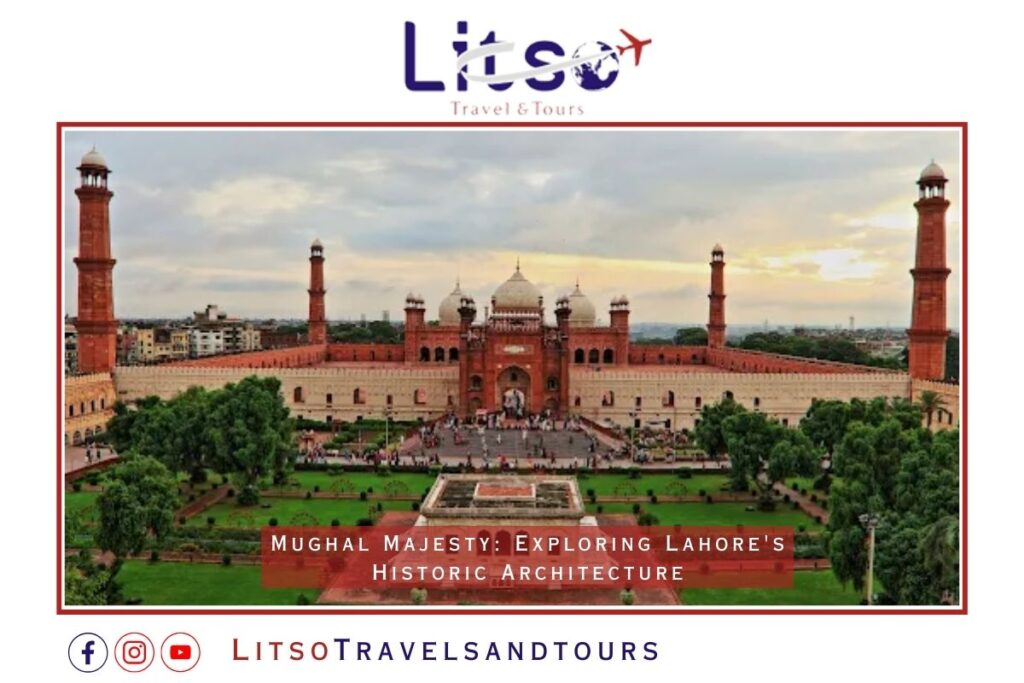Lahore, a city steeped in history, stands as a testament to the Mughal era’s grandeur and architectural brilliance. The Mughals, known for their opulent taste and cultural refinement, left an indelible mark on Lahore, shaping its skyline with magnificent structures that continue to captivate visitors. In this exploration of Lahore’s historic architecture, we delve into the majestic Lahore Fort, the enchanting Shalimar Gardens, the awe-inspiring Badshahi Mosque, and the enduring influence of Mughal design within Lahore’s Walled City.
Introduction
Lahore, often referred to as the heart of Pakistan, holds a rich tapestry of history and cultural heritage. At the center of this narrative lies the Mughal era, a period of splendor and architectural innovation. Mughal architecture, characterized by its intricate designs and grandiose structures, has left an enduring legacy in Lahore.
The Grandeur of Lahore Fort
Historical Background
The Lahore Fort, a UNESCO World Heritage Site, boasts a history dating back to the 11th century. However, it was under the Mughals, particularly Emperor Akbar, that the fort underwent significant expansion and beautification.
Architectural Features
Intricate Carvings and Motifs
One cannot help but marvel at the detailed carvings and decorative motifs that adorn the fort’s walls and gateways. Each element tells a story, reflecting the cultural richness of the Mughal era.
Royal Quarters and Audience Halls
Within the fort’s expansive grounds, the royal quarters and audience halls stand as silent witnesses to the grandeur of Mughal rule. The Diwan-i-Khas, with its stunning marble tracery, exemplifies the sophisticated taste of the Mughal emperors.
Shalimar Gardens: Nature’s Paradise
Creation by Shah Jahan
Commissioned by Emperor Shah Jahan, the Shalimar Gardens are a testament to the Mughals’ appreciation for nature’s beauty. The garden’s design reflects the Persian influence on Mughal landscaping.
Layout and Design Elements
Terraced Levels and Flowing Water Channels
The garden’s terraced layout, coupled with flowing water channels and cascading fountains, creates a serene and visually appealing environment. Each terrace unfolds a new layer of beauty, symbolizing the Mughal penchant for symmetry and order.
Significance of the Garden’s Name
“Shalimar” translates to “abode of love,” and indeed, the garden embodies the Mughal concept of paradise on Earth. Its name resonates with the romanticism that characterized the Mughal rulers’ approach to architecture.
Badshahi Mosque: A Symbol of Grandiosity
Construction During Aurangzeb’s Reign
Commissioned by Emperor Aurangzeb, the Badshahi Mosque stands as one of the largest mosques in the world. Its construction was completed in 1673, and the mosque remains an architectural marvel to this day.
Architectural Details
Massive Domes and Minarets
The Badshahi Mosque’s sheer size is awe-inspiring, with its massive domes and towering minarets. The red sandstone and marble construction contribute to the mosque’s grandiosity, making it a prominent feature of Lahore’s skyline.
Courtyard and Prayer Halls
The vast courtyard can accommodate thousands of worshippers, emphasizing the communal spirit of Mughal architecture. The prayer halls, adorned with calligraphy and intricate tilework, showcase the Mughals’ attention to detail in religious structures.
Mughal Influence on Lahore’s Walled City
Integration of Mughal Elements in the City
Lahore’s Walled City, a bustling maze of narrow streets and markets, bears the unmistakable imprint of Mughal influence. From architectural remnants to the layout of bazaars, the Mughals shaped the very fabric of this historic city center.
Street Layout and Bazaars
Architectural Remnants Within the City Walls
As one navigates the labyrinthine streets of Lahore’s Walled City, glimpses of Mughal architecture emerge unexpectedly. Dilapidated havelis and ancient gateways transport visitors back in time, underscoring the enduring legacy of the Mughals.
Cultural Impact on Local Communities
Beyond the physical structures, the Mughals’ cultural impact on local communities is palpable. Traditional crafts, cuisine, and societal norms within the Walled City bear traces of the Mughal era, creating a unique blend of the old and the new.
Legacy of Mughal Architecture in Modern Lahore
Preservation Efforts
Recognizing the importance of preserving Lahore’s Mughal heritage, various conservation projects have been initiated. Efforts to restore and maintain these architectural gems aim to ensure their longevity for future generations.
Influence on Contemporary Structures
Balancing Modernity with Historical Charm
Modern structures in Lahore often draw inspiration from Mughal architecture, striking a delicate balance between contemporary functionality and historical charm. Architects and urban planners carefully integrate Mughal design elements to create a seamless blend of past and present.
Architectural Conservation Projects
Government initiatives and collaborations with international organizations seek to safeguard Lahore’s Mughal structures. Conservation projects involve meticulous restoration work, preserving the intricate details that define Mughal architecture.
Challenges in Preserving Mughal Architecture
Environmental Factors
Pollution and Weathering
The impact of environmental factors, including air pollution and weathering, poses a significant challenge to preserving Mughal structures. The delicate carvings and intricate details are susceptible to degradation over time.
Preservation Strategies
Implementing effective preservation strategies is essential to combat the challenges posed by environmental factors. Advanced conservation techniques, periodic maintenance, and public awareness campaigns play crucial roles in ensuring the longevity of Lahore’s architectural treasures.
The Timeless Allure of Mughal Structures
Tourist Attractions and Cultural Significance
Lahore’s Mughal structures continue to attract tourists from around the world. The timeless allure of the Lahore Fort, Shalimar Gardens, and Badshahi Mosque lies not only in their architectural magnificence but also in their cultural significance.
Local Events and Celebrations Held at Mughal Sites
The open courtyards and expansive gardens of Mughal structures serve as venues for various local events and celebrations. Festivals, cultural performances, and community gatherings further highlight the living heritage embedded in these architectural marvels.
Exploring Lahore’s Historic Architecture: A Personal Experience
Visitor Testimonials
Visitors often share profound experiences of exploring Lahore’s historic architecture. The overwhelming sense of history, coupled with the breathtaking beauty of Mughal structures, leaves an indelible mark on those who immerse themselves in this cultural journey.
Impact on Cultural Awareness and Appreciation
Exploring Lahore’s historic architecture fosters cultural awareness and appreciation. It not only connects individuals to the city’s rich history but also instills a sense of responsibility to preserve and celebrate this heritage for future generations.
Conclusion
In conclusion, Lahore’s historic architecture, shaped by the Mughals, stands as a testament to the city’s cultural richness. The Lahore Fort, Shalimar Gardens, Badshahi Mosque, and the Walled City collectively weave a narrative of grandiosity, artistic finesse, and enduring legacy. Efforts to preserve and integrate Mughal influences into modern structures ensure that this majestic heritage remains a source of inspiration for generations to come.







